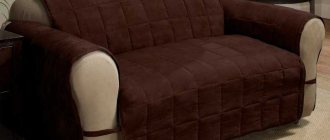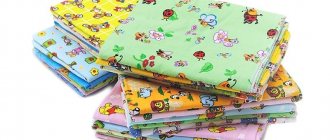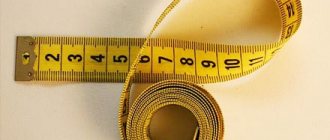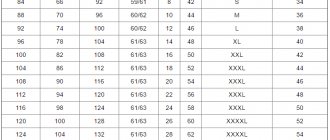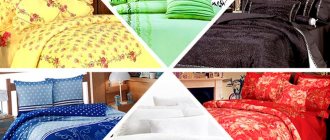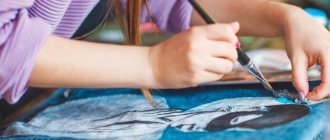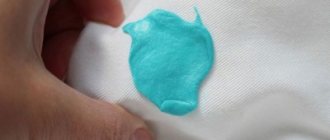Romper with an elasticated belt is an indispensable clothing for the first months of life for every baby, especially for those born in the cold season! Comfortable knitted pants with closed legs will provide your child with complete freedom of movement, and you will not have to constantly adjust his socks.
We offer you a pattern of rompers for newborns and will tell you in detail about the sequence of work.
How to sew a children's vest: patterns, sewing instructions, photos, videos
Fabric for sewing a vest
- While most adults can wear synthetic fabrics without any discomfort, children need high-quality materials. Manufacturers of children's clothing prefer cotton flannel or chintz.
- The main thing is that the material must be 100% natural. When purchasing fabrics, you should check with the seller for a quality certificate.
- Vests should be sewn from high-quality white fabrics. This is due to the fact that they are not pre-coated with dyes, which can cause allergies in the child.
Sewing a vest
In addition to cotton, chintz and flannel, you can use the following materials for sewing a vest:
- madapolam
- batiste
- paper
Construction of a vest pattern
- Now we will tell you how to sew a wrap-around vest that will be secured with a button or button.
- After you decide on the material (be sure to take into account seasonality), you can transfer the pattern to the fabric. The pattern you like can be found on the Internet for free.
- If the pattern is intended for children aged 2-3 months, and your child is a little older, then you can increase the pattern to the size that is needed.
- First of all, decide on the length of your clothes. Measure the distance from shoulder to hips.
The width is ½ the circumference of the chest. To prevent the vest from being too tight, you can add a few centimeters to the width of the garment. This way your child will feel comfortable, because the vest will not hinder his movements.
Step-by-step pattern instructions:
HomeDescription
Sewing a vest
Step-by-step instructions for sewing a vest:
- When the patterns are transferred to the fabric, all the details need to be cut out.
- Sew the vertical section of the sleeve.
- Pin the shirt tab to the shelf using a pin.
- Connect all the elements and stitch them.
- Sew the bottom of the vest and the neckline.
- To keep the shelves in place, buttons or buttons are attached to them. The loops into which the buttons will be inserted need to be sewn.
Sewing a vest
The length of the sleeve
- It is important to determine the correct sleeve length so that the child is comfortable. If you are going to sew a vest with short sleeves, then 7 cm will be enough.
- If you plan to wear a vest with scratches, then you need to add another 4-5 cm to the total length of the sleeve. This will protect the baby from injuries received from marigolds.
Master class: sewing rompers
Kuryshkina Yu. A.
To sew the rompers I needed:
ready-made romper pattern, size 74;
- knitted cooler fabric;
- knitted fabric cash-corse for the belt;
- linen elastic (36 cm).
- This is what you should get:
I slightly changed the pattern of the belt (since at home we wear onesies without a diaper). The pattern is given in finished form (already with seam allowances):
Step 1 . We cut out the details. I made seam allowances of 0.7 cm (the width of the overlock stitch).
Step 2. Baste the sock to the front half of the rompers.
Step 3. Stitch the parts using an overlocker. Overlock is best suited for sewing knitwear. For those who don’t have an overlocker, you can first sew an elastic stitch for knitwear or a narrow zigzag stitch, and then finish the edge with a zigzag stitch.
Step 4. Baste or pin the front and back halves of the pants.
Step 5. Sew down the parts.
Step 6. Turn one pant leg right side out and insert it into the other, aligning the middle front sections of the parts and the middle back sections of the parts.
Step 7. We sew away or pin off the middle sections and grind down the parts.
Step 8. View of the sliders from the front side.
Step 9. On the wrong side of the sliders we apply a mark and baste it.
Step 10. Grind the mark. It is better to grind it by placing the part next down (see photo).
Step 11. Cut out the belt and cut off two corners. This is necessary in order to create a hole for inserting the elastic.
Step 12. Overlay these slices.
Step 13. Sew the belt into a ring as shown in the photo.
Step 14. Fold the belt in half (widthwise) and iron it.
Step 15. The belt has 2 sides: front and back, on which there is a processed hole. Apply the front side of the waistband to the front side of the rompers and baste or pin. The hole for the elastic should be at the back.
- Step 16. Sew on the belt
Step 17. Pull the elastic into the waistband and the sliders are ready.
Other master classes:
Pattern of rompers for newborns
In order to cut out the rompers, you need to take measurements.
Measure:
- Distance from baby's shoulder to foot;
- Distance from armpit area to foot;
- Pants leg length;
- Height (if you will wear onesies on a diaper, increase the length of this line by 3 cm, and reduce the length of the pant leg by the same amount;
- The width of the trouser leg at the bottom (so that you can wear it freely);
- Width of sliders;
- The length of the baby’s foot (cut the foot to a size so that the leg is not cramped).
For babies with chubby legs, additionally measure the width of the trouser leg at the top so that it is not too narrow.
Knowing all these dimensions, you can accurately cut out and easily sew the sliders.
When cutting out sliders, be sure to add allowances:
- The seam allowance is 0.2 – 0.5 cm, depending on the type of processing;
- If necessary, add a growth allowance of 7 cm;
- If desired, add a loose fit allowance of 2.5 cm if you are sewing from stretch fabric and 4 cm if the fabric does not stretch well;
- If you are cutting according to a ready-made pattern, be sure to compare it with the sizes that you have (it is possible that it has already taken into account allowances for a loose fit and for growth). When cutting out sliders, place them along the grain thread.
Sew all the parts in the following sequence:
- Sew the toe, gusset and yoke (if you have them) to the front half;
- Sew the front and back halves along the side seams;
- Sew the front and back halves along the seam of the inner edge of the legs;
- Sew in the foot;
- Treat seams;
- Process the top edge of the sliders and make a fastener.
This is interesting: Pattern Romper for children (p 50-86 (0-18 months))
How to sew baby onesies with your own hands: patterns, sewing instructions, photos, videos
- One of the most common clothes for babies is rompers. If you don't have sewing skills, don't worry. The process will take a little time.
- You don't have to buy a sewing machine. All seams can be made using regular thread and needle.
Types of baby onesies
There are different models of baby rompers. You have the right to choose the option that will look perfect on your child and will not cause him discomfort.
The most popular models:
- Classic. They reach to the waist;
- Romper in the form of overalls;
Products with decorations have also been created, which can be with socks on the feet or with elastic bands on the ankles. This model can reach to the waist or to the armpits. Sliders can also be held in place using elastic bands or straps. A distinctive feature is the location of the seams, which can be on the inside or outside.
Fabric selection
- Considering that the sliders will come into contact with the baby’s skin, you need to take a responsible approach to choosing the material. It is best to use natural cotton, as it does not provoke allergic reactions and allows the skin to breathe. That is, the baby will not develop heat rash - red spots on the skin that cause discomfort and itch.
- The fabric should be pleasant to the touch. Choose materials in natural, delicate shades . If the fabric is too bright, it means that dyes were used in production, which can be dangerous for the baby. Give preference to stretchy fabric so that your child’s movements are not constrained. You can sew rompers from flannel or terry.
Choose high-quality and natural fabric
How to take measurements to sew rompers?
- Before starting the pattern, you need to measure the length of the trouser leg, the width of the leg and the length of the foot.
- If you plan to sew rompers in the form of overalls , then first measure height .
- It is important to know the distance from the foot to the armpit and from the foot to the shoulder . This is necessary to ensure that the rompers are appropriate for the child's age. They should not be big or small on him.
How to sew rompers from a T-shirt?
If you have a T-shirt or tank top in your wardrobe that you won't wear again, you can use it to sew baby onesies.
Prepare the following materials:
- A T-shirt or T-shirt from which the product will be sewn.
- Threads that match the color. There should be no contrast.
- Scissors.
- Romper suits your baby's age.
- Sewing machine.
The sewing process will take no more than half an hour. If you have enough free time, you can make several models.
Step by step sewing procedure:
- Layer the existing rompers onto the T-shirt. Before doing this, the T-shirt needs to be turned inside out.
- Trace the product with a pencil or pen.
- Cut off excess material.
Cut off the excess
- Lengthen the back of the slider a few centimeters so that your child's foot will fit.
- Support and round the cut of the toe section.
Make it round
- Align the cut of the sock on the front and back of the sliders.
- Form a fold. The distance from the toe to the fold should be equal to the length of the child’s foot. Sew the seams.
Combine and make a fold
- Hem the hem located at the top edge of the side seam.
- Cut all threads and iron the product.
Trim off all unnecessary
- Insert the rubber band.
Insert an elastic band
- You can put rompers on your child.
How to sew classic rompers?
If you want to sew classic rompers, follow these instructions:
- Print out the pattern you have chosen.
- Transfer the pattern to the fabric, tracing the edges with chalk.
- Cut out the blanks, leaving a margin of 1 cm.
Cut it out
- Separately cut out the socks. They will need to be sewn to the trouser leg.
Stitching
- Connect the front and back parts of the product, align the cuts, and sew the seams.
- Fold the belt right side inward and stitch it into a ring. Turn it inside out to create a seam.
Belt measurements
- Insert the elastic into the waistband and sew the seam on the waistband to the side seam.
- Sew all seams using a machine and iron them.
- Use as directed.
Video: The simplest slider model?
How to sew romper jumpsuits?
This model is made a little more complicated, but it turns out more interesting and warmer.
You will get such a jumpsuit. Instructions that are convenient to save.
How to decorate rompers?
There are different ways to decorate baby onesies. You can use these tricks:
- Sew bright pockets with flowers or the sun on them.
- Make beautiful and unique inscriptions. Often the child's name is embroidered on rompers and vests.
- Sew on cartoon images with interesting inscriptions.
- Sew a beautiful and bright bow if the clothes are sewn for a girl.
- Make beautiful straps.
Create beautiful clothes
So, now you know how you can sew rompers or vests for children at home. As you can see, it is not necessary to contact a specialist for this. If you stock up on the necessary materials and free up a little time, you can contribute to your baby's wardrobe.
How to sew rompers: tips
A child doesn’t need a lot of strength and skills to sew rompers herself. You don't have to look for any complicated patterns. The rompers or panties that you have will help you create clothes for your baby. Look how simply they are made, no unnecessary decorations or complex details. You can use them as a template.
To make your baby comfortable in rompers, pay more attention to the choice of fabric and seam processing. The fabric should be light, natural and soft, like cotton. The seams should not rub against the legs and cause discomfort. The elastic band should never be too tight!
Fabric selection
These clothes come into contact with the baby's skin. Therefore, the choice of fabric is very important. The following must be taken into account:
- The use of natural cotton is recommended. It has important advantages: it cannot cause allergies, it allows the child’s skin to breathe and it can absorb moisture well.
- The texture of the fabric is pleasant to the touch.
- You need to choose knitwear of a suitable color. If the color is too bright, then a dye may have been used that is not suitable for the child. It is recommended to choose a fabric of a delicate color.
- It is necessary that the chosen fabric can stretch. If this does not happen, then it will significantly hinder the child’s movements.
You may be interested in this Rules for using Janome manual sewing machines
In order for the fabric to meet the listed recommendations, you can pay attention to flannel, terry cloth or cotton jersey.
Sewing clothes for a child
Taking measurements to create a pattern
When you need to make rompers for newborns with your own hands, patterns for the classic version are based on the following measurements:
- leg length;
- the width of the trouser leg at the bottom should be such that the baby can put them on freely;
- slider width;
- child's foot length.
Sliders
If you plan to make them in the form of overalls, you will need to additionally measure the following:
- height;
- distance from foot to armpits;
- distance from foot to shoulder.
Important! If your baby has chubby legs, you will need to measure their circumference at the top.
Based on the measurements taken, you can prepare a pattern of rompers for a newborn. The following must be taken into account:
- Seam allowance is required. Its value should be in the range from 2 to 5 millimeters.
- As the baby grows, it makes sense to allow for an allowance to sew for growth. It is recommended that its length be 7 centimeters if the fabric does not stretch, and 4 if it does stretch.
- It may be worth making allowances for clothing to fit loosely around the child. Its recommended value is 2.5 centimeters.
Based on the obtained dimensions, a relatively simple pattern is made that answers the question of how to sew sliders.
Several models for babies
This is interesting: Pattern Romper with straps (height 62-86 cm)
Preparing your baby's wardrobe
Since babies grow very quickly, a new mother should not prepare dozens of things of the same size. In the first month of life, a baby will need 3-4 baby vests, the same number of rompers and two or three baby caps. Bodysuits, scratchies and, of course, diapers will also come in handy.
It’s not difficult to sew all this at home with your own hands. It is enough to arm yourself with sewing patterns for newborns and creative inspiration.
When choosing fabric for a tiny wardrobe, it is important to consider what season the baby plans to be born. For summer items, cotton fabric, chintz, and calico are suitable. Warm outfits can be sewn from flannel and flannel.
When creating a pattern, it is optimal to take measurements directly from the “model”, however, universal drawings were created for sewing for future use. To determine the parameters of the necessary clothing, you can use the table of clothing sizes for a newborn baby.
Materials and tools
Sewing the classic version for a baby is not very difficult. An example calculation is made for size 74.
For the master class on sewing rompers you will need the following materials:
- 0.5 meters of cotton knitwear.
- 37 centimeters of linen elastic.
- Threads for sewing.
- Scissors.
- Sewing machine to get the job done.
Having prepared the necessary tools and materials, you can immediately begin work.
Baby in rompers
What is better to buy or sew rompers for newborns yourself?
The skin of a newborn baby is so sensitive that any contact with “suspicious” matter can cause irritation or a dangerous allergic reaction. Rompers appear in a child’s life from the very first days; it is with them that the baby’s skin most often comes into contact, so it is extremely important when purchasing them to pay due attention to quality. Below we will look at the main nuances that will help parents choose the safest and most comfortable pants for their beloved child.
Rompers for newborns - what is it?
Romper is a type of children's clothing that consists of pants, usually closed at the bottom, but this is a generalized concept. In fact, it is quite a functional and comfortable wardrobe item. The unique cut provides the baby with freedom of movement, and a wide range of design solutions allows them to be used not only as home wear, but also as a weekend outfit.
What types of rompers are there for babies?
- Pants with an elastic waistband . It is best to use it in combination with a bodysuit, then the back of the child will remain closed. The disadvantage of such models is that they can slide, causing inconvenience to the baby.
- Sliders on adjustable straps. The regulator can be buttons, rivets or elastic bands. The model is quite budget-friendly. Not all families have the opportunity to buy new pants every month, due to the fact that the old ones are already small. This type of sliders will be an excellent option, because if necessary, it is enough to replace the fastener with one element.
- With closed and open feet. For newborn children, it is better to choose the first ones, then socks can be neglected, but the legs will still be warm.
- Romper overalls. Probably one of the most popular models. Convenient rivets located between the legs make the process of changing diapers much easier.
- Pants with straps, ties or buttons. Very comfortable when paired with blouses and vests.
How many rompers does a newborn baby need and what kind?
The minimum from which to start is 5 pieces . Where does this figure come from? Everything is simple, one for the baby, two for drying and two more, as they say, “just in case.” More is possible, but not less.
Purchase each model in a single copy, and then observe which one the child feels more comfortable in. But don't forget to take your interests into account. For example, it is much easier to wear onesies at night, since changing a diaper at this time of day should be done promptly.
Important point! At discharge, as well as for the first time, until the baby’s umbilical wound heals, preference should be given to onesies without elastic bands. Otherwise, the latter will cause frequent crying, as it will cause pain to the baby.
How to choose rompers for your baby in the store?
In order not to create unnecessary problems for yourself or your child, when choosing sliders, try to adhere to the following rules:
Important point! Before you start using sliders, be sure to wash them, and then thoroughly steam the panties with an iron.
At what age can you put rompers on a newborn?
There are no age restrictions on this, it all depends on what is convenient for you and your child. Some babies are capricious when they are in a diaper and immediately calm down as soon as they find themselves in pants and a vest; others prefer to be “wrapped up” rather than free.
Sizes: how to choose the right size of rompers for a newborn?
Babies are born, as a rule, of the same height, so when choosing wardrobe items, this indicator is taken as the starting point. If your baby has not yet been born and the onesies are being purchased for the future, then choose standard sizes. The most popular is 56 , but some babies are born premature or smaller than standard sizes, where smaller onesies may be needed - 46-50 rubles.
In this matter, be guided by: better more than less. To protect yourself and not miss the size, buy pants with straps; then, even if they are too big, the fasteners will prevent them from falling off.
How to sew rompers for a newborn yourself?
A favorite pastime of pregnant women is going to baby stores. A mother wants the best and most beautiful things for her child.
You can buy a lot, but it’s much more pleasant to dress your baby in things that you made with your own hands, with all the love and care. Here are the main methods for making baby onesies.
You will be surprised how simple and fast it is, and most importantly, this way you can guarantee the safety of the product.
Romper patterns for newborns: where to get them and how to use them?
Standard pattern.
You can adjust it yourself, based on the individual characteristics of your child.
You need to transfer the image onto the fabric, to do this:
How to sew rompers on a sewing machine?
Romper with elastic: pattern
How to sew rompers for a newborn? Sliders with elastic are more convenient to use when they do not put pressure on the baby's tummy. Therefore, you need to choose a wide elastic band or sew a belt separately from a well-stretching fabric. If you choose the second option, then keep in mind that on the proposed pattern you need to make the belt a little wider. Enlarge the finished pattern to the desired size and print. The easiest way to adjust the size is to use a finished product of the same model (that is, sliders with an elastic band, if you plan to sew just like that, or pants with an elastic belt made of fabric).

